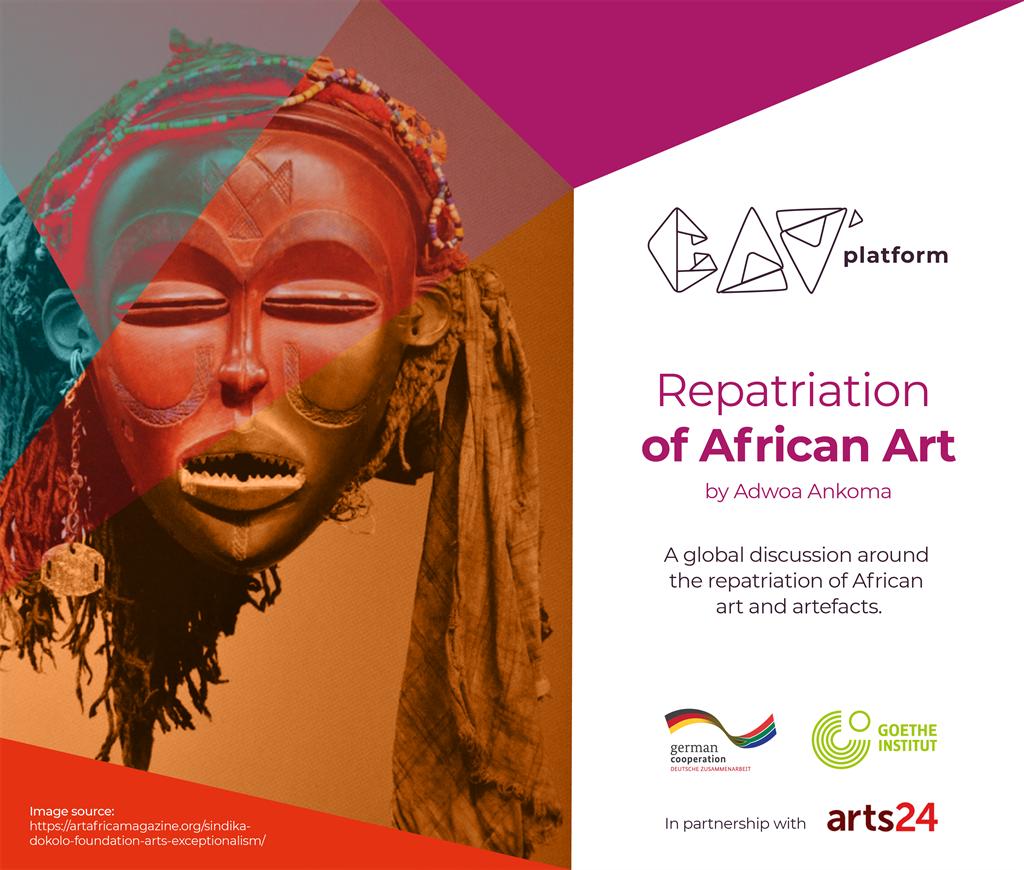
Africa-Press – South-Africa. A reckoning is happening, a willingness, like none before, for the former colonial powers, both those who sat at the Berlin conference, and those who benefited indirectly, to acknowledge the past, what was taken and what needs to be returned.
In 2015, Germany made a conditional acknowledgement, a decade after offering an initial apology for the 100 year anniversary of the Namibian Genocide of 1904-1904 , as documented in its own records. The question of reparations remains unsettled. The atrocities committed during this period, include the sending of skulls of OvaHerero and Nama victims of colonialist crimes to Germany. The subsequent journey to repatriate the human remains from Germany is captured in the 2016 documentary ‘Skulls Of My People’ directed by Vincent Moloi. In 2018, Namibia received the skulls at a handing over ceremony in the capital, Berlin. In June 2020, the Namibian President Geingob reportedly stated in his State of the Nation address “The Federal Republic of Germany has agreed that the events of 1904 -1908 can be termed genocide and they are ready to render an apology, at the highest level of German government”
In 2017, in a move that sent shockwaves through the art world, French President Emmanuel Macron publicly engaged the topic of restitution of African art from French collections, committing to results within the following five years. A tacit acknowledgement of a long denied history of mass looting of African art. A report was commissioned and written by French historian Bénédicte Savoy and Senegalese economist Felwine Sarr recommending the return of African art. This was a groundbreaking development. The collection of African art over the years could arguably be viewed as a French foreign policy issue. The announcement by President Macron was followed by the temporary leasing back of sculptures to Benin from the Quai Branly Museum in France. Such public willingness to even consider facilitating the return of African art could set a precedent for many collections held across the world. It definitely lends credibility to the advocacy for return. In July of this year, France discussed draft legislation which would enable the restitution of looted artefacts to Benin and a historic sword to Senegal.
Most recently, in a year of the second global wave of Black Lives Matter protests, Switzerland’s city of Zurich, long known for maintaining a reputation of neutrality, commissioned and published a report, acknowledging that it’s banking system made money through links to the slave trade. “The study highlights several investments, direct holdings and trade links between the Swiss city and slavery, mainly in the 18th century. The city itself bought shares in the British South Sea Company that enslaved an estimated 36,000 Africans during the lifetime of the investment.”.
For the creative and cultural industries, these acknowledgements and repatriations are primed to be a major catalyst for the repatriation of African art, and in some cases remains in the form of mummies, once looted, or at best paid for but greatly undervalued, that now exists as a significant driver of the global art economy. The conversation around the repatriation of African art is getting louder and bolder.
Who can forget the now iconic ‘Killmonger in the museum’ scene from Marvel’s Black Panther (2018) film, in which the antagonist Killmonger has a conversation with a museum expert about the African art on display, correcting her about the origin of a specific piece of art and how it was acquired by the museum. “How do you think your ancestors got this? Do you think they paid a fair price or did it take it like they took everything else?” In the scene Killmonger echoes a wider discussion about how the art came to be at the museum, and whether in fact the artefacts on display, were in fact art.
Whether framed in the context of decolonisation; participating in a major global economy; or simply achieving redress after hundreds of years of widespread colonial and precolonial looting, the discussion on what is art, and then further, who are the most appropriate custodians and caretakers of these cultural and artistic works is no longer easily dismissed. There is an acknowledgement that Black Lives Matter, an acknowledgement that colonialism stemmed several atrocities including mass looting.
Traditionally, those who advocate for restitution and repatriation have always had to convince those who argue for the retention of looted artifacts in encyclopedic museums in the Global North. However, the increased stability of African countries, increased capability of housing art, digitisation and globalisation has reopened the case for return, questioning in a new light, the validity of old arguments.
Recently a new gallery collaboration called ‘South-South’, a website that will operate as “a curated portal for the galleries ”and will include “an auction live streamed in the manner if the big auction house” is harnessing the art market’s reinvention in the light of these changes. Ideas of decolonisation are all over the project, with a flattened globe with no right side up, visually repositioning the role of the South in the global art market, and words like “Veza”, which means “reveal”, replacing the colonially stained “auction”.
The increased capacity of African countries to maintain ‘world class’ art institutions has further weakened the paternalistic argument that the art is safer where it currently resides in the Global North. Digitisation has enabled encyclopaedic collections to exist virtually, without needing physical display collections. Digitisation however, is not a simple solution, as with it comes a host of new legislative issues to be contemplated including copyright of Artificial Intelligence, digital collections and 3D holograms, all viable alternatives for encyclopedic museums.
One of the arguments against the repatriation, has always been the existence, the value and perpetuation of the ‘encyclopedic museum’. The idea that the center of the world is elsewere, and the rest of us, the global South, benefitting only from contributing to this center in exploitative ways.
An encyclopedic or universal museum collects arts from around the world and brings it to one convenient location, often to illustrate a particular point of view. The mission of the encyclopedic museum is to collect, protect, and preserve the world’s ‘treasures’ and keep them available for the future for all human-kind. These institutions enjoy great esteem in the art world for this mission. They allow you to “walk the world in one location”. The ambitions of the encyclopedic museum can hardly be faulted, but the issue is which location? If African countries were in fact to recall all the art of African origin, entire exhibitions of some of the world’s biggest museums would be emptied, leaving gaps in a carefully sourced and researched visual encyclopedia .
Where there is great resistance to a movement for redress, it is often worthwhile to follow the money. Art tourism is big business. And so are the art auctions. Annually, an average of 10 million people visit the Louvre in France, the world’s largest art museum, and on most days, admissions is paid, between 15 € (R271) and 17 € (R301) per adult depending on the day.
The museums with the ‘rarest’ and largest collections have an easier time of establishing and anchoring themselves as iconic institutions. Repatriation advocates for African art to be viewed and consumed, and at times recontextualised, where thesubjects of the art reflect those who are viewing the art, rather than the art being used to give perspectives about the ‘other’. It advances a cause of accessibility, in a time when many Africans, from the countries where much of the art originates, don’t have the means to travel to these encyclopedic museums . , as they reside in countries for whom many Africans must jump through hoops to get a visa. A post colonial Africa wants a piece of that pie at home.
Equitable participation in the art and museum economy could potentially revitalise the economies of many African countries. Even if the art is never physically returned, but is returned in title, there is room for African countries to generate revenue from leasing out these collections to the locations in which they currently reside.
Calls for decolonisation in a post colonial Africa have amplified this movement for return or at least for custodianship and control. The discussion of recontextualization, which acknowledges the evolution of the borders of African states has itself been put forward as an argument against repatriation. Much of the art that originated from Africa can not be attributed to any one country or tribe that exists today. Even amongst African countries there is a question of which country has the stronger claim.
A coordinated, regional policy position on the repatriation of African art is long overdue and the willingness for former colonial powers to acknowledge the looting, presents a rare opportunity. Africa has rarely been able to define its own aesthetic, including the ability to decide what is art, what can leave, what can be lent out, what can be sold and ensure that African countries and Africans benefit from this economy and tourism. This includes revisiting the ethics of archaeology and culture with Egyptian Sarcophagi and art which some cultures in fact consider living ancestors (such as the Native American Hopi ‘artefacts’) or totems forming part of the debate.
Regionally, there have been some developments. In 2017, South African introduced the Draft National Policy on the Repatriation and Restitution of Human Remains and Heritage Objects. In 2019, the Economic Community of West African States (ECOWAS) developed a draft regional action plan for the return of African cultural property to their countries of origin, which was discussed at a meeting of Directors of Cultural Heritage and Museum of the Economic Community of West African States, and whose stakeholders include the African Union, ECOWAS Heads of State and Government, West African Economic and Monetary Union (UEMOA) and Member States.
African countries have been encouraged to ratify the International Institute for the Unification of Private Law (UNIDROIT) Convention on Stolen or Illegally Exported Cultural Objects and the United Nations Educational, Scientific and Cultural Organization (UNESCO) Convention on the Means of Prohibiting and Preventing the Illicit Import, Export and Transfer of Ownership of Cultural Property
Art is ultimately about identity. It is important for African people to be able to define and appreciate African art and antique collections in an accessible and affordable manner as well as benefit from the commodification of African art. Open Restitution Africa “is an Africa-led project seeking to open up access to information on restitution of African material culture and human ancestors, to empower all stakeholders involved to make knowledge-based decisions”. Open Restitution is gathering and highlighting African voices, ensuring that whatever actions taken reflect a knowledge based, definitive, coordinated stance on the repatriation of African art.
What lends increased support for this renewed and more concretised conversation about the repatriation of African Art is that the conversation is mirrored by non African countries. The ongoing litigation around Italy’s claim to the Victorious Youth bronze in the Los Angeles Getty Museum and Greece’s claim to the Elgin Marbles in the British Museum have anchored a dialogue about the value of encyclopedic museums and policies on repatriation of art are being revisited. It isn’t simply a policy position pushed forward by Africans of first nation communities. It is an ongoing question about the claims of nation states, and whether those claims should be given priority over the ability of encyclopedic museums to protect and preserve the art.
This article is the second of the Cav’ series, which looks at art and policy-making on the continent. This article was produced in partnership with the Goethe CAV Platform, a platform to strengthen the cultural and creative industries by the Goethe-Institut.





